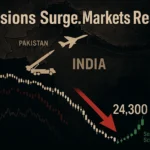A Day of Red: What Triggered the Chaos?
You know it’s a rough day when the markets wear red like it’s Valentine’s Day gone wrong. On May 8, the Indian stock market had one of its most dramatic falls in recent months—and this wasn’t just one of those “profit booking” dips. No, this one came with missiles, media mayhem, and major panic.
Let’s decode this free-fall.
Operation Sindoor: From Defence Strategy to Market Stress
The heart of today’s market drama? India launched Operation Sindoor, a military strike targeting 9 terror sites in Pakistan and Pakistan-occupied Kashmir (PoK). While the operation was meant to crush terror infrastructure, it ended up crushing investor confidence too.
Pakistan, of course, didn’t just sit and watch. Reports claimed counterstrikes and even drone shoot-downs. Suddenly, what started as a “surgical move” turned into full-blown geopolitical tension. And if there’s one thing stock markets hate more than bad quarterly results, it’s uncertainty mixed with war headlines.
Panic Mode: Nifty Sinks, Sensex Suffers
Let’s look at the scoreboard:
| Index | Close (May 8) | Change |
|---|---|---|
| Nifty 50 | 24,235 | -333 pts (-1.36%) |
| Sensex | 79,151 | -1,062 pts (-1.32%) |
| India VIX | 21.4 | +10.1% |
(Source: NSE, BSE)
The India VIX, often called the “fear index,” surged over 10%, reminding everyone that peace-time rallies can turn into war-time sell-offs pretty fast.
Rupee Takes a Hit: Hello, 85+
As if equity investors didn’t have enough to worry about, the Indian Rupee fell to ₹85.71 against the US Dollar, a drop of nearly 1%. That’s the worst single-day performance in over two years.
Why does this matter?
- A weak rupee makes imports (especially oil) more expensive.
- Foreign investors get nervous and might pull money out.
- Inflation fears creep back in.
Basically, the rupee’s fall adds fuel to the already raging fire.
Sector-Wise Breakdown: Who Got Hit the Hardest?
Some sectors got battered harder than others. Here’s how the damage spread:
- Auto Stocks: Mahindra & Mahindra, Maruti Suzuki, and Tata Motors faced the heat due to global risk-off sentiment.
- Banking Stocks: PSU banks saw heavy selling amid fears of foreign outflows.
- Metals: With global uncertainties rising, stocks like Tata Steel and Hindalco fell sharply.
- IT Stocks: Surprisingly calm—thanks to their export-heavy model and weak rupee advantage.
If this were a cricket match, IT was the only player scoring runs while the rest of the team got out duck.
Foreign Investors: Ready to Pack Bags?
Foreign Institutional Investors (FIIs), who had been net buyers recently, suddenly remembered that they have options—like US treasury bonds, which don’t launch missiles.
With rising volatility, a weak rupee, and fear of prolonged conflict, the FII inflow tap could turn dry fast. No one likes staying at a party where fireworks might turn into firebombs.
Global Trouble Didn’t Help Either
To make things worse, the U.S. Federal Reserve played the buzzkill by signaling they’re still worried about inflation and aren’t cutting rates soon.
That means:
- Global liquidity might remain tight.
- Risky assets (like emerging market stocks) look even riskier.
- Safe havens (like gold and USD) become more attractive.
Perfect storm? You bet.
What Should You Do Now?
If you’re a long-term investor:
Don’t panic. Wars don’t last forever (hopefully), but good businesses do. This could be a buying opportunity if you know what you’re doing.
If you’re a trader:
Tighten stop losses and maybe avoid sectors that are highly sensitive to global risk-off like metals, banks, and autos.
If you’re new to the market:
Take a deep breath. This is not the first time India has faced such tensions—and the markets have bounced back before.
Final Thoughts: Markets Hate Missiles
The Indian stock market fall on May 8 wasn’t just about numbers. It was about fear—fear of escalation, fear of the unknown, and fear of being caught in the crossfire of geopolitics and global macro.
But remember, markets overreact in the short term and normalize in the long run.
FAQs
What caused the Indian stock market fall on May 8, 2025?
The market fell due to escalating India-Pakistan tensions after Operation Sindoor, weak rupee, global risk-off sentiment, and panic selling.
Which sectors were most impacted?
Auto, banking, and metals saw the biggest losses. IT remained relatively stable.
Is it a good time to invest now?
Only if you’re in it for the long haul and understand the risks. Volatility will remain high.
Will the market recover soon?
Historically, geopolitical shocks cause short-term volatility. Recovery depends on how fast tensions ease.
How did the rupee perform today?
The rupee dropped nearly 1% to ₹85.71 against the USD—its worst fall in two years.
Related Articles
Tata Motors Demerger: What Is The Future of Tata Motors?






